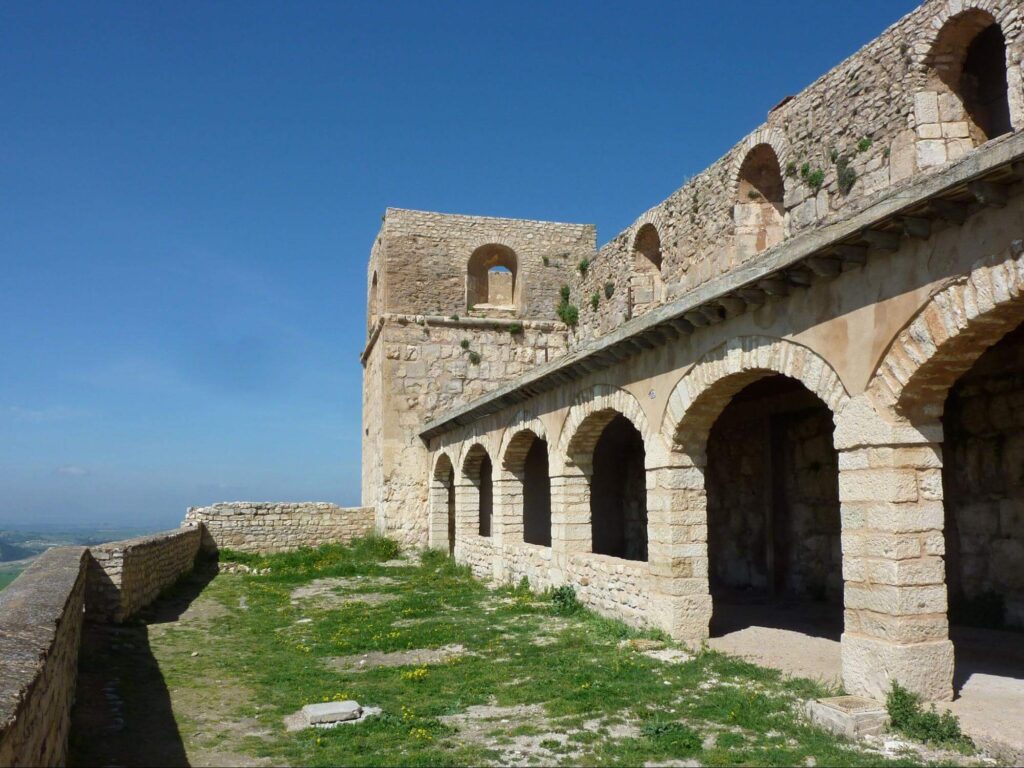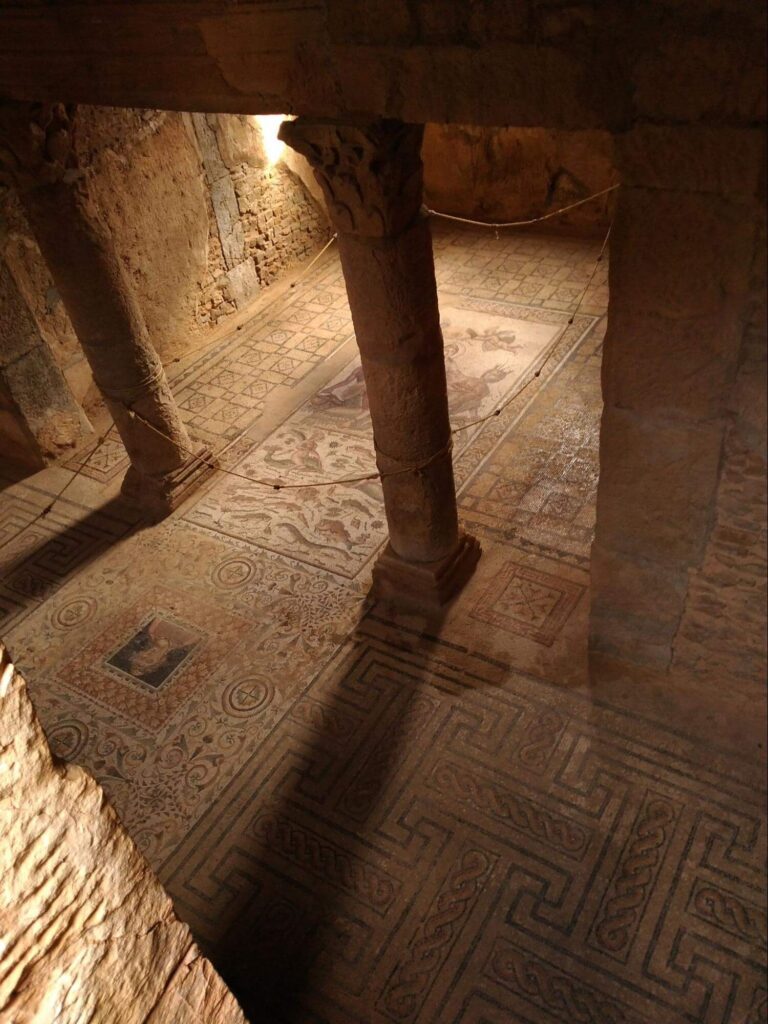Join Far Horizons on a captivating 16-day journey through Tunisia, a country of incredible diversity and profound historical significance. Nestled along the North African coastline, Tunisia is a testament to the forces of nature and vicissitudes of history. Verdant mountains, serene lakes, and tranquil rivers paint a picturesque landscape in the north, while the awe-inspiring Sahara desert in the south offers a stark contrast with its powerful scenery and intermittent oases.
Tunisia’s strategic location beside the narrow straits of Sicily has ensured its place at the heart of the Mediterranean’s tumultuous history. It has witnessed the rise and fall of numerous civilizations, each leaving traces of their presence. The Phoenicians, Romans, Vandals, Byzantines, Spanish, Turks, and French have all marked their passage, contributing to the country’s rich cultural tapestry.
Under the expert guidance of Dr. Jennifer Tobin, a Greco-Roman specialist, the Far Horizons’ Wonders of Tunisia tour offers an unrivaled exploration of this remarkable country. Our love for this fascinating destination has led us to craft a tour that takes in all seven of Tunisia’s UNESCO World Heritage Sites, including the Roman city of Dougga, the historic medinas of Sousse and Tunis, the Punic ruins of Kerkouane, the splendid Carthage, the sacred city of Kairouan, and El Jem, home to the largest Roman amphitheater in North Africa.
The journey weaves through Phoenician remains: Roman amphitheaters and aqueducts, Byzantine fortresses, desert oases, centuries-old mosques, and vibrant Berber (Amazigh) fortified villages.
From the fertile northern mountains to the deserts of the south and the shimmering Mediterranean Sea coast of the east, a tour of Tunisia offers an array of unforgettable sights and experiences.
We hope the following guide to Tunisia’s culture and history will inspire you to begin planning your dream trip to the country. If, however, you’ve yet to decide where to travel on your next adventure, be sure to explore our full selection of Worldwide Archaeological Tours.
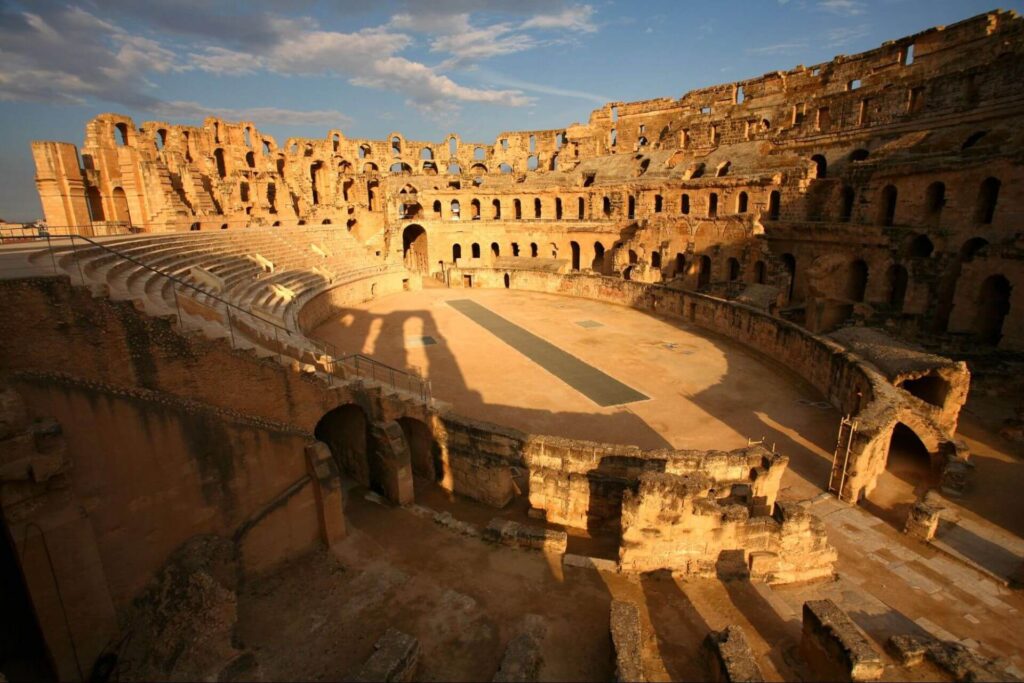
Tunisia’s Rich History
Tunisia’s past is as diverse as it is fascinating. It begins with the indigenous Amazigh (Berber) people, who have inhabited North Africa since prehistoric times. The richness of their culture continues to resonate in Tunisia’s customs, language, and arts.
Next, the storied era of Greco-Roman influence is epitomized in the ruins of Carthage, a city-state once Rome’s greatest rival in the Mediterranean.
Once the center of Phoenician trade in the Mediterranean, Carthage eventually became the wealthiest city in the Mediterranean, boasting a harbor with over 200 docks. The impact of this ancient power and influence can be witnessed in Tunisia’s architecture, infrastructure, and even its agricultural practices.
Following the decline of the Roman Empire, the Islamic conquest transformed Tunisia, leading to the rise of the Arab-Andalusian architectural style, which can still be seen in many of its towns and cities.
Lastly, French colonization from 1881 to 1956 significantly impacted Tunisia’s modern society. Blending Tunisian traditions and European influences in education, politics, and cuisine. Tunisia’s history is one of convergence and transformation, lending the country its unique and captivating identity.
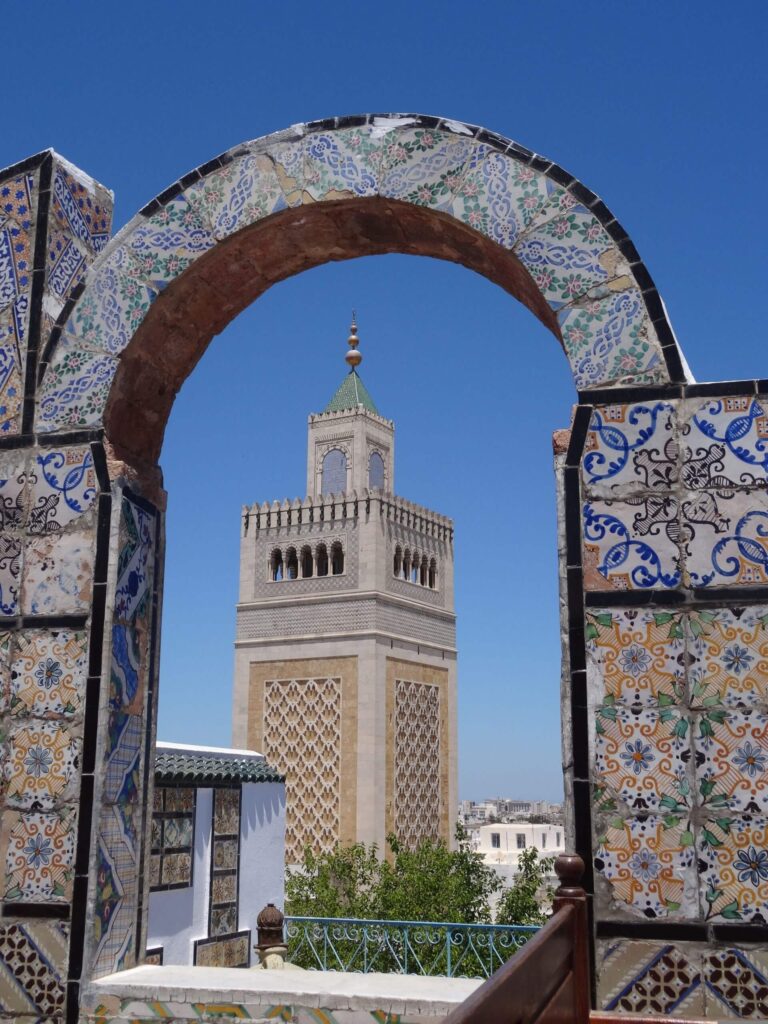
Tunisia’s UNESCO World Heritage Sites
Tunisia is home to seven UNESCO World Heritage Sites, each bearing testament to the country’s history and archaeological sites. The ruins of Carthage, perhaps the most well-known among them, hark back to when the city was a major power in the ancient world. Today, visitors can explore the remnants of Roman villas, public baths, and the formidable Antonine Baths.
The Medina of Tunis is another UNESCO site that invites visitors into a labyrinthine network of narrow streets, souks, mosques, and palaces. This ancient city center encapsulates the essence of Arab-Islamic architecture and urban planning.
The archaeological site of El Jem boasts one of the largest and best-preserved Roman amphitheaters in the world. It is a remarkable testament to Roman imperial architecture and their love for pomp.
Kairouan, Sufetula (Sbeitla), and Kerkouane are other UNESCO sites showcasing different aspects of Tunisia’s past. Kairouan is revered as a spiritual and cultural hub of Islam in the Maghreb region, while Sufetula features the ruins of a Roman town with its temples and arches. Kerkouane, on the other hand, is a unique Phoenician-Punic archaeological site that provides insights into daily life in ancient times.
Exploring these sites is not merely about witnessing the remnants of the past but understanding the stories they hold.
When travelers visit Tunisia with Far Horizons, their encounters with these wondrous historical sites are illuminated by Dr. Jennifer Tobin, whose knowledge of the Classical Mediterranean world is second to none. With her academic credentials and ability to speak multiple languages, including English, Modern Greek, German, French, Italian, and Turkish, Dr. Tobin’s guidance will ensure you immerse yourself in the Wonders of Tunisia to a profound degree.
The Grandeur of Greco-Roman Sites
Chemtou, Le Kef, and Maktar are notable sites that illustrate the grandeur of the Graeco-Roman world in Tunisia. Once the hub of North Africa’s marble industry, Chemtou showcases how Roman Tunisia’s economic ties extended across the empire. Le Kef’s Byzantine fort and Roman basilicas speak to the religious diversity that marked this period, highlighting the amalgamation of beliefs in ancient Tunisia.
Makthar, known for its public buildings graced with intricate mosaics, offers a window into the luxurious lifestyle enjoyed by Roman elites. The preserved artistry and architectural designs provide invaluable insight into the time’s social hierarchy and aesthetic values.
Among these historic sites, Dougga stands as the best-preserved Roman town in North Africa. It invites visitors to explore its monumental temples and theater, which overlooks the sprawling landscapes of Tunisia, offering an intimate glimpse into the city’s historical narrative.
Further sites such as Uthina (Oudna), Thuburbo Majus, and Zaghouan continue to reveal the country’s Graeco-Roman past. From Uthina’s ancient ruins of a Roman villa to Zaghouan’s remarkable aqueduct, each location is a window into a unique chapter of Tunisia’s rich history.
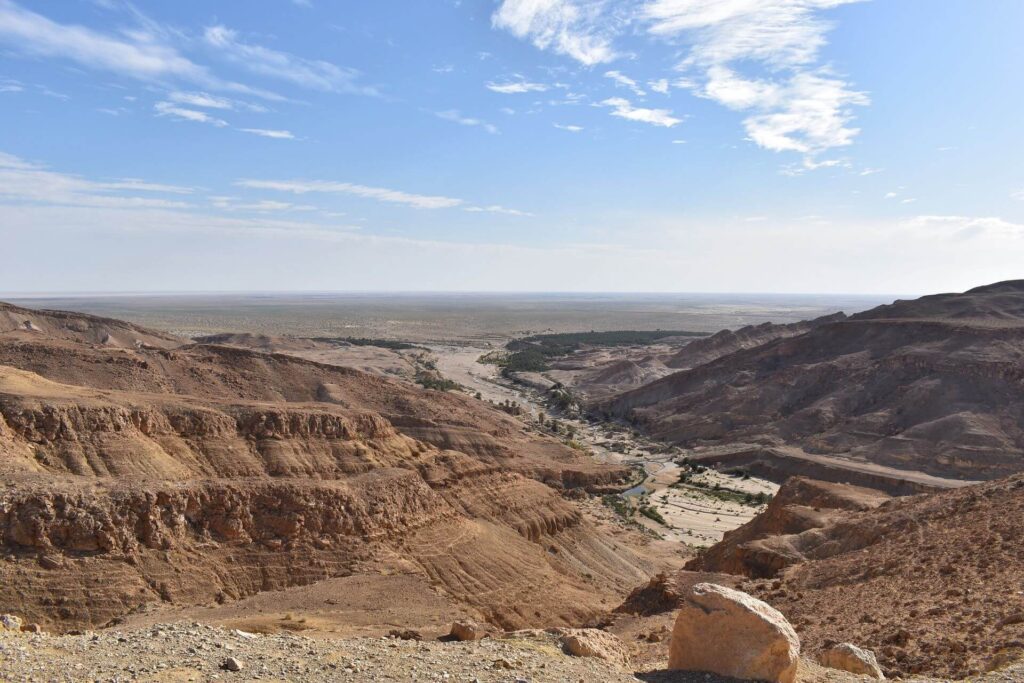
The Beauty of Southern Tunisia: Oasis Villages and Striking Desert Landscapes
Southern Tunisia invites exploration into a stunning landscape adorned with palm-fringed oasis villages and expansive desert vistas. Tamerza, Mides, and Nefta form a trio of picturesque oasis villages celebrated for their traditional architecture, tranquil palm groves, and rejuvenating waterfalls.
Chebika, fondly known as the “Castle of the Sun,” showcases the country’s immense natural beauty. A serene spring at the foot of the Djebel el Negueb mountain creates an oasis amidst the rugged desert landscape.
The expansive Chott El Jerid, the largest salt pan of the Sahara, offers a surreal spectacle of shimmering salt crystals stretching across the horizon. Nestled within this vast desert is Matmata, renowned for its traditional Berber homes carved into the ground. This unique form of architecture provided residents with natural insulation from the desert’s harsh climate, demonstrating the ingenious adaptations of the Berber culture to their environment.
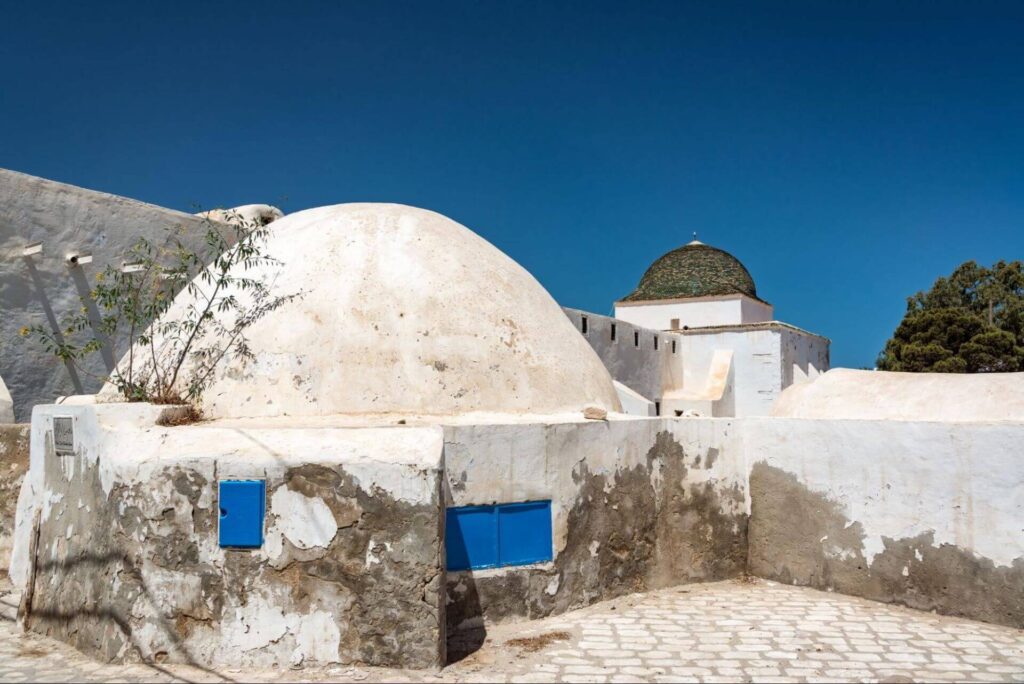
Djerba Island
The allure of Tunisia’s coastal beauty is best captured on the enchanting Djerba Island. Known as the “Island of Dreams,” Djerba is a delightful, paradisal island offering pristine beaches, lush palm groves, and fascinating local culture.
Myths have long proclaimed that the glorious island of Djerba was the fabled Land of the Lotus Easters in Homer’s Odyssey. On this unique island, you’ll find whitewashed desert towns and vibrant souks influenced by Berber, Arab, Jewish and African cultures.
Djerba’s Ghriba Synagogue is home to one of the oldest Torahs in the world. Close by is Borj el Kebir, an ancient castle built in the 14th century above the Roman city of Griba, which offers fantastic views over the Mediterranean.
We visit all of these extraordinary sites on our Wonders of Tunisia tour.
Bulla Regia and the Unique Underground Homes
In the northwest of Tunisia lies the archaeological site of Bulla Regia, a Roman city famed for its unique underground dwellings. Built this way to escape the heat of the summer and the cold of the winter, these homes are unparalleled in the Roman world.
While under direct Roman rule, Julius Caesar made Bulla Regia a free city. While under the emperor Hadrian, all citizens of the city were granted full Roman citizenship. The city fell in status during the Byzantine Empire and was eventually abandoned. Fortunately, drifting desert sands helped to preserve the historic site.
Visitors can explore the houses’ subterranean levels, complete with open-air courtyards and rooms adorned with well-preserved mosaics depicting scenes from Roman mythology. The “House of Amphitrite” is particularly noted for its exquisite mosaics, showcasing a charming depiction of Amphitrite, the sea goddess, in a chariot drawn by sea horses.
The City of Tunis
Finally, the city of Tunis, the capital of Tunisia, is a must-visit site when exploring Tunisia. It is home to the UNESCO World Heritage Site of the Tunis Medina, a historical center that encapsulates Tunisia’s rich past.
Visitors will find themselves winding through narrow, cobbled streets filled with bustling markets (souks), historic palaces, and grand mosques.
Highlights of the medina include the Zitouna Mosque, completed in 864 CE and the largest mosque in Tunisia, and the Dar Hussein Palace, which houses the National Institute of Archaeology and Art.
As you wander through Tunis’ labyrinth of history, you’ll find yourself lost in the stories of the Medina and its many past inhabitants over the centuries
Reflection on Tunisia’s Heritage
Tunisia’s history is not merely the sum of its archaeological sites and monumental structures; it’s a living tapestry woven from thousands of years of human endeavor. It’s a blend of cultures, a melding of horizons, and a testament to the resilience and creativity of its people.
The remarkable itinerary compiled at Far Horizons for our Wonders of Tunisia tour offers a glimpse into Tunisia’s past and a deeper understanding of its present. By exploring ancient cities, diverse landscapes, and rich traditions, participants gain insight into the complex layers of Tunisia’s history and culture. Under the expert guidance of Dr. Jennifer Tobin, our travelers are treated to an exploration of this marvelous country that is quite simply spellbinding.
If you have any questions concerning our trip to Tunisia, please get in touch. If you’ve yet to decide where you’d like to travel on your next adventure, please visit Far Horizons’ Tour Calendar to discover the rich list of fabulous countries we visit in the company of expert historians and archaeologists.
